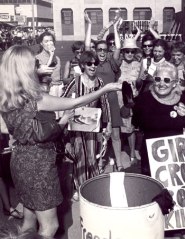The notion that “bra-burning” was a widespread element of feminist protest is a media myth that’s probably too engrained, and euphonic, ever to be thoroughly debunked.
It’s a notion that’s given rise to much hyperbole since the late 1960s. An Associated Press report yesterday added to the overstatement reflex with this astounding and wrong-headed passage about “bra-burning“:
“Culturally, beatniks were becoming mods, rock ‘n’ roll was taking hold, and the move from stockings to pantyhose — and eventual bra-burning — all influenced mid-’60s fashion.”
The AP report was about how the Mad Men television series has reflected “the evolution of fashion” during the 1960s.
But it wasn’t such froth that caught the attention of Media Myth Alert: It was the absurd claim that “bra burning … influenced mid-1960s fashion.”
Left unsaid by the AP report was how — how “bra-burning,” even if it were a frequent manifestation (which it wasn’t), could have influenced fashion of that time.
The AP claim was especially puzzling because the “bra burning” meme did not even emerge until the late 1960s, when it came to be associated with the Miss America protest at Atlantic City on September 7, 1968.
A centerpiece of the 1968 protest was the “Freedom Trash Can,” into which demonstrators deposited so-called “instruments of torture” — including brassieres, girdles, high-heeled shoes, false eyelashes, and copies of magazines such as Playboy and Cosmopolitan.
Organizers of the demonstration have long insisted that no bras were set afire that day — that there was only a “symbolic bra burning” at Atlantic City.
But “bra-burning” is a nuanced media myth — as I describe in my latest book, Getting It Wrong.
I discuss in the book two previously overlooked witness accounts that bras were burned, briefly, during the protest at Atlantic City, which often is credited with marking the rise of the feminist movement of the late 20th century.
One of the witness accounts was published the day after the protest in the Press of Atlantic City, beneath the headline:
“Bra-burners Blitz Boardwalk.”
The newspaper report, written by a veteran reporter named John L. Boucher, included this passage:
“As the bras, girdles, falsies, curlers, and copies of popular women’s magazines burned in the ‘Freedom Trash Can,’ the demonstration reached the pinnacle of ridicule when the participants paraded a small lamb wearing a gold banner worded ‘Miss America.’”
The other witness account discussed in Getting It Wrong was that of Jon Katz, a writer who covered the 1968 protest as a young reporter for the Atlantic City newspaper.
“I recall and remember noting at the time that the fire was small, and quickly was extinguished, and didn’t pose a credible threat to the Boardwalk. I noted this as a reporter in case a fire did erupt,” Katz told me, adding:
“It is my recollection that this burning was planned, and that a number of demonstrators brought bras and other articles of clothing to burn, including, I believe some underwear.”
These witness accounts offer fresh dimension to the legend of bra-burning: They represent evidence that bras and other items were set afire, if briefly, at the 1968 protest in Atlantic City.
“This evidence,” I write in Getting It Wrong, “cannot be taken lightly, dismissed or ignored.”
I also point out, though, that neither witness account lends “support to the far more vivid and popular imagery that many bras went up in flames in flamboyant protest that September day. [The] accounts offer no evidence to corroborate a widely held image of angry feminists demonstratively setting fire to their bras and tossing the flaming undergarments into a spectacular bonfire.”
The reference in the AP report to “bra burning” as a fashion-molder is not only wrong; it suggest the insidious nature of media myths — how they can be invoked so readily and casually, without reference to any supporting evidence or detail.
They’re often treated as if they’re common knowledge, widely accepted.
And “bra-burning” is a media myth with a sting. The term often has been employed casually, as derogatory epithet, to ridicule feminists and dismiss their objectives as trivial and insignificant. As such, “bra-burning” underscores the potential of media myths to feed and promote stereotypes.
Not to mention misleading impressions of fashion history of the 1960s.
Recent and related:
- James Fallows and ‘furnish the war’: Indulging in a media myth
- Wasn’t so special: Revisiting the ‘Cronkite Moment,’ 44 years on
- Bra-burning, a myth that ‘will never die’?
- Remembering bra-burning — er, make that bra-smoldering
- The editor and the protest: Bra-burning’s intriguing sidebar
- Bra-burning in Toronto: Confirmed
- ‘Doctrinaire feminist in the bra-burning mold’?
- Invoking media myths to score points
- Why they get it wrong
- Getting It Wrong goes on Q-and-A


[…] fact, feminist “bra-burning” was mostly a […]
[…] How’s that? ‘Bra-burning’ influenced mid-1960s fashion? […]
[…] The “napalm girl” image figured in a recent New York Times obituary about Horst Faas, a gruff, German-born photographer who spent years in Vietnam, covering the conflict for the AP. […]